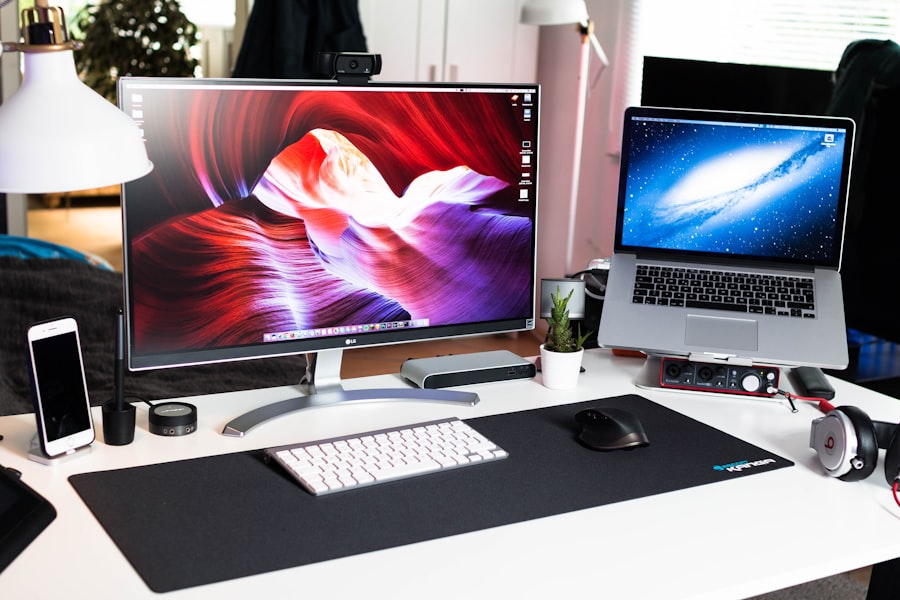A well-organized workspace is the cornerstone of workstation productivity and efficiency. When your environment is cluttered, it can lead to a chaotic mindset, making it difficult to focus on the tasks at hand. Start by decluttering your desk and removing any items that do not serve a purpose in your daily work routine.
This includes old papers, unused office supplies, and personal items that may distract you. Once you have cleared the space, consider implementing a system for organizing the essentials for workstation productivity. Use trays, folders, and labels to categorize documents and supplies, ensuring that everything has a designated place.
This not only makes it easier to find what you need but also creates a visually appealing environment that can enhance your mood and motivation. In addition to physical organization, digital organization is equally important in today’s technology-driven world. Take the time to sort through your computer files, deleting unnecessary documents and creating folders for easy access to important information.
Utilize cloud storage solutions to keep your files secure and accessible from anywhere, which can be particularly beneficial for remote work. Furthermore, consider using productivity tools and apps that help you manage your tasks and deadlines effectively. By establishing an organized workspace both physically and digitally, you set the stage for increased focus and productivity, allowing you to tackle your responsibilities with greater ease.
Key Takeaways of Worksation Productivity
- Keep your workspace clean and organized to improve focus and productivity.
- Prioritize your tasks by urgency and importance to ensure you are working on the most critical items first.
- Minimize distractions by turning off notifications and finding a quiet space to work.
- Use time management techniques such as the Pomodoro method to stay focused and efficient.
- Take regular breaks to rest your mind and avoid burnout, improving overall productivity.
- Streamline your processes by finding ways to automate or simplify repetitive tasks.
- Invest in ergonomic equipment to reduce strain and discomfort, improving overall health and productivity.
Prioritize Your Tasks
Effective task prioritization is essential for managing your workload and ensuring that you are making progress on your most important projects. Begin by creating a comprehensive list of all the tasks you need to complete, then evaluate each one based on its urgency and importance. The Eisenhower Matrix is a useful tool for this purpose, as it helps you categorize tasks into four quadrants: urgent and important, important but not urgent, urgent but not important, and neither urgent nor important.
By identifying which tasks require immediate attention and which can be scheduled for later, you can allocate your time and energy more effectively. Once you have prioritized your tasks, it’s crucial to remain flexible and adaptable as new responsibilities arise. Regularly review your task list and adjust your priorities as needed, ensuring that you are always focused on what matters most.
This dynamic approach not only helps you stay organized but also reduces feelings of overwhelm that can arise from a long to-do list. By honing your ability to prioritize effectively, you empower yourself to make informed decisions about where to direct your efforts, ultimately leading to greater productivity and satisfaction in your work.
Minimize Distractions

In an age where distractions are abundant, learning how to minimize them is vital for maintaining focus and productivity. Begin by identifying the specific distractions that affect you most—these could range from social media notifications to background noise in your environment. Once you have pinpointed these interruptions, take proactive steps to mitigate their impact.
For instance, consider using website blockers during work hours to limit access to distracting sites or setting your phone to “Do Not Disturb” mode while you concentrate on important tasks. Creating a dedicated workspace that is free from distractions can also significantly enhance your ability to focus. Moreover, fostering a culture of respect for focused work within your team or household can further reduce interruptions.
Communicate your need for uninterrupted time with colleagues or family members, establishing boundaries that allow you to work without constant interruptions. Additionally, consider implementing techniques such as the Pomodoro Technique, which encourages focused work sessions followed by short breaks. This method not only helps maintain concentration but also provides structured intervals for rest, making it easier to stay engaged with your work while minimizing distractions.
Utilize Time Management Techniques
| Technique | Effectiveness | Benefits |
|---|---|---|
| Prioritizing tasks | High | Increased productivity, reduced stress |
| Setting goals | Medium | Improved focus, motivation |
| Time blocking | High | Enhanced efficiency, better work-life balance |
| Eliminating distractions | High | Improved concentration, faster task completion |
Time management techniques are invaluable tools for enhancing productivity and ensuring that you make the most of each workday. One popular method is time blocking, which involves scheduling specific blocks of time for different tasks or activities throughout the day. By allocating dedicated time slots for focused work, meetings, and breaks, you create a structured routine that helps prevent procrastination and encourages accountability.
This approach allows you to visualize your day more clearly and ensures that you are dedicating sufficient time to high-priority tasks. Another effective technique is the two-minute rule, which suggests that if a task can be completed in two minutes or less, you should do it immediately rather than putting it off. This simple principle can help clear small tasks from your to-do list quickly, preventing them from piling up and becoming overwhelming.
Additionally, consider using digital tools such as calendars or task management apps to keep track of deadlines and appointments. By incorporating these time management techniques into your daily routine, you can enhance your efficiency and create a more balanced approach to work.
Take Regular Breaks
The importance of taking regular breaks cannot be overstated when it comes to maintaining productivity and mental well-being. Working for extended periods without breaks can lead to burnout and decreased focus over time. To combat this, implement a structured break schedule that allows you to step away from your work periodically.
Short breaks of five to ten minutes every hour can help refresh your mind and prevent fatigue, while longer breaks during lunch or mid-afternoon can provide an opportunity for deeper relaxation and rejuvenation. During these breaks, engage in activities that promote relaxation and mental clarity. This could include stretching exercises, taking a brief walk outside, or practicing mindfulness techniques such as deep breathing or meditation.
These activities not only help clear your mind but also improve overall physical health by reducing stress levels and promoting circulation. By prioritizing regular breaks in your work routine, you create a sustainable approach to productivity that fosters creativity and enhances overall job satisfaction.
Streamline Your workstation productivity Processes

Identifying Areas for Improvement
Streamlining processes is essential for maximizing efficiency in any work environment. To achieve this, it’s crucial to evaluate your current workflows and pinpoint areas where bottlenecks or redundancies occur. This involves analyzing how tasks are assigned, completed, and reviewed within your team or organization.
Simplifying Processes for Enhanced Efficiency
By simplifying these processes—whether through automation tools or clearer communication channels—you can reduce the time spent on repetitive tasks and free up resources for more strategic initiatives. Implementing standard operating procedures (SOPs) for recurring tasks within your organization is also beneficial. Documenting these processes ensures consistency and provides a reference point for team members when completing their work.
Boosting Productivity and Onboarding
Streamlining processes not only enhances efficiency but also facilitates onboarding new employees who can quickly familiarize themselves with established workflows. By documenting and standardizing processes, you create an environment where productivity thrives, allowing team members to focus on high-value activities rather than getting bogged down in unnecessary complexities.
Invest in Ergonomic Equipment
Investing in ergonomic equipment is a crucial step toward creating a comfortable and productive workspace. Prolonged periods of sitting at a desk can lead to various health issues such as back pain, neck strain, and repetitive strain injuries. To mitigate these risks, consider upgrading your office furniture with ergonomic chairs that provide proper lumbar support and adjustable features that cater to individual body types.
Additionally, investing in sit-stand desks allows employees the flexibility to alternate between sitting and standing throughout the day, promoting better posture and reducing fatigue. Beyond chairs and desks, other ergonomic accessories such as keyboard trays, monitor stands, and wrist supports can further enhance comfort during work hours. These tools help maintain proper alignment while typing or viewing screens, reducing strain on the body over time.
Furthermore, creating an ergonomic workspace not only benefits individual health but also contributes to overall workplace morale and productivity. Employees who feel comfortable in their environment are more likely to remain engaged in their tasks and produce higher-quality work. By prioritizing ergonomic investments in the workplace, organizations demonstrate their commitment to employee well-being while fostering a culture of productivity and efficiency.


